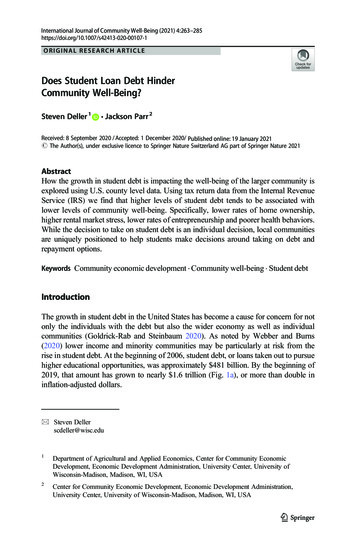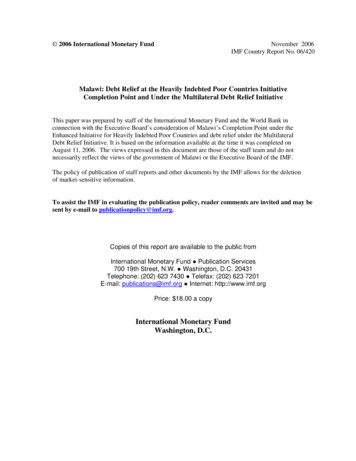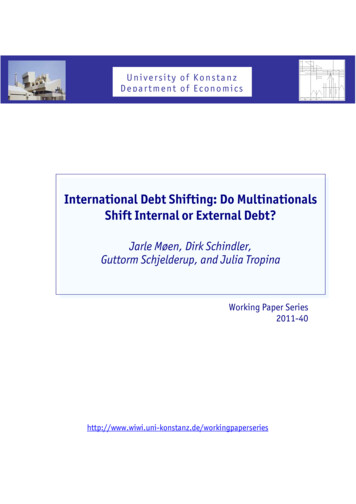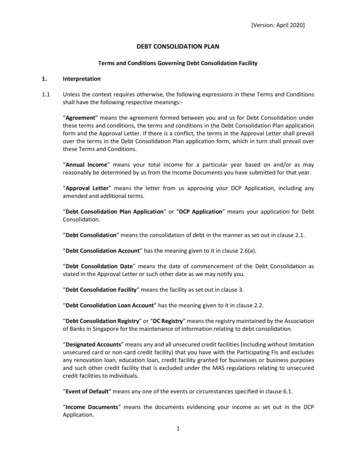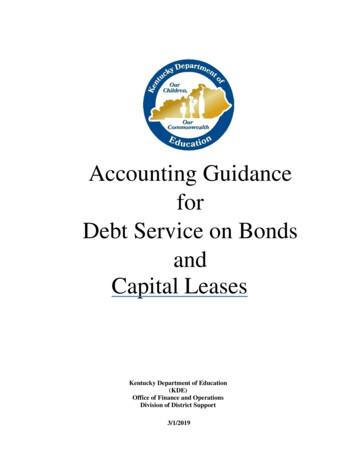
Transcription
Accounting GuidanceforDebt Service on BondsandCapital LeasesKentucky Department of Education(KDE)Office of Finance and OperationsDivision of District Support3/1/2019
ACCOUNTING GUIDANCE FOR DEBT SERVICE ON BONDS AND CAPITAL LEASESContentsContents . 2General Bond Sale Information & Accounting Guidance on Bond Debt Service . 3Terms and Requirements . 4Recording Guidance on Bond Debt Service . 7Sample Accounting Entries on Bond Debt Service . 7Example Accounting Journal Entries on Advanced Refunding Bond: . 9Expenditures in debt service fund 400: . 10Advanced Refunding Bond - Journal Entries . 11Example Accounting Journal Entries on Current Refunding Bond . 15Current Refunding Bond Assumption Example: . 15Three wire transfers on the settlement date:. 15The district then sends a check to the escrow account to fully defease the old issue: . 15Current Refunding Bond - Journal Entries . 17Example Accounting Journal Entries on Revenue Bond: . 19Revenue Bond Assumption Example:. 20Revenue Bond - Journal Entries . 22Capital Lease Debt Payment Guidance and Entries . 25Capital Lease Payments Made Directly by the School District . 25Sample entries: How to record KISTA bus capital lease purchases in MUNIS: . 25How to record other capital lease payments in MUNIS in fund 1 will be recorded:. 262
ACCOUNTING GUIDANCE FOR DEBT SERVICE ON BONDS AND CAPITAL LEASESGeneral Bond Sale Information & Accounting Guidance on Bond Debt ServiceA school district may issue original (new) bonds or refund (refinance) existing bonds in accordance with KRS 160.160 and 702 KAR3:020, 702 KAR 4:160 and 750 KAR 1:010.The district shall contract with a fiscal agent and bond counsel as specified under 702 KAR 3:020 when issuing bonds to receivefinancial & advisory services and to assist in developing and finalizing the revenue, refunding and KISTA bond issues. The fiscalagent will assist the school district in preparing a financing plan including funds available for debt service and proposed debtservice schedule.The fiscal agent request that KDE schedule the revenue and/or refunding bond sale with amount, date, time and type of bond.KDE will review, verify and approve and/or deny revenue and refunding/refinancing bond sales based on each school district’sfinancial soundness, as well as substantiate amounts, dates, times and laws supported within the bond documents.The following documents and information must be received by KDE at least ten working (10) days prior to the bond sale: Preliminary Official Statement(s) Report – (required from fiscal agent on revenue and refunding bonds) A legal documentfor revenue and/or refunding bond in a preliminary form, which serves as a prospectus of the bonds and discloses the terms,finances, and legal requirement, which indicates how investors in the bonds will be repaid with support of the district’sfinancials. Plan of Financing Report (required from fiscal agent on revenue only bonds) The fiscal agent will formulate and develop aPlan of Financing to support the financial soundness using the most up-to-date financing techniques, including all financingoptions, budgeting constraints and bonding capacity. Plan of Refinancing Report (required from fiscal agent on refunding only bonds) The fiscal agent will formulate and developa Plan of Refinancing for refunding bonds to support the financial soundness of the bond using the most up-to-date financingtechniques including all financing options, budgeting constraints, and bonding capacity. In addition, the Plan of Refinancingshall demonstrate a 5% net present value cost savings and include the remaining payment schedules of the old refundedbonds and payment schedule of the new refunding bond. Bond Payee Disclosure Form Report (fiscal agent on revenue only bonds) The Bond Payee Disclosure Form is a report of thecost associated with the sale of the bonds) that must be submitted to the Legislative Research Commission (LRC) for reviewby the Capital Construction and Bond Oversight Committee if School Facilities Construction Commission (SFCC) fundsare involved. The Capital Construction and Bond Oversight Committee reviews and makes recommendations on the bondissue before the sale. SFCC requires this information to be submitted by noon one working day prior to the above fourteen(14) day deadline set by the Committee. Notice of Bond Sale and Terms and Condition Report (required from bond counsel on revenue and refunding bonds) Anofficial document publicized by an issuer of a revenue and refunding bond, which provides relevant information regarding anupcoming bond issue and invites bids from prospective underwriters, brokers or investor. The terms and conditions presentsthe details of the bond plan, legal requirements and any written amendments.The preliminary official statement and plan of financing must also be submitted to SFCC, if SFCC funds are involved at least tenworking (10) days prior to the bond sale.3
ACCOUNTING GUIDANCE FOR DEBT SERVICE ON BONDS AND CAPITAL LEASESRevenue bond issuance review and verification begins with determining the financial soundness of the requested and approvedfunding sources and is verified, if the funding sources are available for bonding capacity as reported on the BG-1 and the “Plan ofFinancing”. Revenue bond issues are proceeds that are used to fund a construction project and are always accounted for in theconstruction fund 360 since this is the fund from which all planned capital expenditures are made. It is not appropriate, to place a portionof the bond proceeds in the general fund to pay the bond issuance cost.Refunding/refinancing bond issuance review and verification begins with determining the financial soundness based on the generallyaccepted industry standard of the realized NPV “net present value” savings of 5%, which is reported in the “Plan of Refinancing”. TheNPV savings should equal 5% of the principal amount of the bonds being refunded. Rather than strictly apply the 5% NPV rule to allschool refunding bond issues, some flexibility can be granted, given consideration in the remaining terms, payments and total savingsof the prior bonds. Refunding bond proceeds are placed in the external escrow account which has been set up with the paying agent inorder for the paying agent to pay off the remaining old refunded bond debt, in addition the district will account for the retirement of the oldrefunded bond as an expenditure and the recognize the new refunding bond as revenue in the debt service fund 400.Districts may refinance existing debt for several reasons: saving money, restructuring of payment debt schedule or removing restrictivebond contracts. However, a district attempting to refund debt in order to provide savings for additional and needed bonding capacityshould also consider other ways to increase and maximize bonding capacity beyond just the gross savings of the refunded debt. Thedistricts should understand how gross savings over the term of the debt translates in present day dollars, since the actual value of moneydepreciates over time. This is referred to as “net present value”.Terms and RequirementsAccounting bond issuance is recorded on the delivery date (closing date).Arbitrage is a factor in many bond issues which the concept of arbitrage (positive or negative depending on current bond marketconditions). Positive arbitrage occurs when the bonds proceeds that are invested produce a higher yield than the tax-exempt bonds.Excess earnings are subject to rebate to the federal government at certain intervals over the life of the bond issue. Several rebateexceptions exist including: small issuer exception, eighteen-month spending exception, and twenty-four month construction spendingexception. Negative arbitrage is the reverse of arbitrage in that the bond proceeds investments are not producing a higher yield thanthe tax-exempt bonds. In some instances, the district must add monies to the escrow account to fully fund the requirements on therefunded bond. If arbitrage (positive or negative) is noted in the rebate calculations, the district should work with their fiscal agentsand independent auditor to make sure the arbitrage has been appropriately reported and accounted for.Bond Discounts is when the interest rate on the bond is less than the market rate of the price and the bond is acquired or sold at adiscount under its par value. The price does not include accrued interest at the date of sale. In some situations revenue bonds mayrequire a transfer from the general fund or debt service fund 400 to cover the reduction of the bond discount. If so, an interfundtransfer is recorded and an interfund receivable should be recognized at the time the bonds are recorded. Also for revenue bonds, if thediscount is decided not to be funded by another fund, the construction fund 360 shall recognize the cash from the bond sale, not thepar value of the bonds (For example, if a district sells a par value bond of 5,000,000, which is then discounted to the purchaser by 200,000, then the district will only receive recognized cash amount of 4,800,000 which shall be placed in the construction fund 360on revenue bonds. Consequently, if the district needed the additional 200,000 to cover a current total project cost, then thedifference of the 200,000 will need to cover by other approved district funds, since they did not receive the total cost of the projectfrom the sale of the bond). Since there is no legal requirement governing how to account for bond discounts, then the bond discountshall be reported as “other financing use” and revenue bonds accounted for in construction fund 360 and refunding bonds accountedfor in the debt service fund 400. Districts desiring to handle bond discounts in a different manner may discuss the issue with theirdistrict’s auditor.Bond Issuance Costs are paid from the paying agent’s external escrow account using excess funds leftover from the new refunding bondproceeds once the defeased refunded bond is paid off. In addition, bond issuance cost can be paid with debt service fund 400, or generalfund 1, if no funds are remaining from the refunding bond proceeds in the external escrow account. Bond issuance costs includes bondattorney costs, financial advisor fees, underwriter fees, bond rating fees, registration fees, other bond costs associated with issuing thebonds. (NOTE: Paying agent fees are paid from the debt service fund 400). Paying agent fees are fees charged by the financialinstitution responsible for making the principal and interest payments on the bonds.) GASB concluded that these costs related to4
ACCOUNTING GUIDANCE FOR DEBT SERVICE ON BONDS AND CAPITAL LEASESissuing debt services in the current period shall be expensed in the current period, with the exception of prepaid insurance. Thisrepresents a significant change from current practice which is to record these as assets and amortize them over the life of the relateddebt issue. See GASB 65 below for accounting requirements.Bond Premium is when the interest rate on the bond is more than the market rate and the excess price of the bond is acquired or sold ata premium over its par value. The price does not include accrued interest at the date of sale. Since there is no legal requirementgoverning how to account for bond premiums, then the bond premium shall be reported as “other financing source” and accounted forin construction fund 360 for revenue bonds and in the debt service fund 400 for refunding bonds. Districts desiring to handle bondpremiums in a different manner may discuss the issue with their district’s auditor.Defeasance termed as the legal release of a debtor from being the primary obligor under the debt, whether by the courts or by thecreditor.Defeased Bonds are no longer an obligation of the district when an outstanding bond is retired, legally and financially, which is doneby refunding them or repurchasing them with cash. Defeased bonds are no longer reported as a liability on the balance sheet and theescrow account will make any remaining payments. Bond Counsel will draft the escrow agreement and renders an opinion on theoutstanding bond being legally (defeased) retired.Entity-Wide Financial Statements - Report for long-term debt and/or other long-term obligations as liabilities in the appropriategovernmental activities statement of net position. Revenue bond premiums and discounts are deferred and amortized over the life ofthe bonds using the effective interest method. Revenue bond payables are reported as net of bond premium or discount. Bond issuancecosts are reported as expenses in the current period. Accrued interest must be reported as a liability. Debt service expenditures relatedto debt service principal and interest payments shall not be included. Also, other financing sources, uses and expenditures associatedwith the issuance of debt should not be included in the entity-wide statements.Escrow Agent is the bank or trust company that holds the government securities and makes payments to the paying agent forthe outstanding bonds.GASB Statement No. 7 - Advance Refunding in Defeasance of Debt SummaryStatement provides guidance on accounting for advance refunding resulting in defeasance of debt recorded in the general long-termdebt account group. The proceeds of the new debt shall be reported as an "other financing source-proceeds of refunding bonds" in thefund receiving the proceeds. Payments to the escrow agent from resources provided by the new debt shall be reported as an "otherfinancing use-payment to refunded bond escrow agent." Payments to the escrow agent made with other resources of the entity shall bereported as debt service expenditures.GASB Statement No. 65: Items Previously Reported as Assets and Liabilities Summary (Effective Fiscal Year 2014)Losses on Refunding Debt - The difference between the reacquisition amount and the carrying amount of the refunded debt typicallyresults in a loss on the refunding transaction. Currently this transaction is recorded as a contra liability and shown net againstoutstanding long-term debt. GASB has determined that this shall be classified as a deferred outflow of resources since an entity mustuse current financial resources to obtain benefits in future periods through adjustments to interest rates or prepayment of terms. It shallbe noted that the balance will still be amortized as a component of interest expense over the shorter of the life of the old or new debt.Governmental Funds (MUNIS Accounting) - Expenditures related to debt service principal and interest payments shall be recognizedin the period due. Bond premiums and discounts are recognized in the current period and premiums on debt issuances are reported as“other financing sources”, while discounts are reported as “other financing uses”. The par amount of debt issued is reported as “otherfinancing sources”. Bond issuance costs are reported in the current period as debt service fund 400 expenditures. Do not report aliability for accrued interest. Report no liability for the un-matured principal of bonds, notes, capital lease obligations and similar debtservice.Refunding/refinancing bond issue are refunded bonds that combine the saving of the refunded bond with the debt of the new refundingbond issues which provides savings and additional bonding capacity that can be used for future bonding on future constructionprojects.5
ACCOUNTING GUIDANCE FOR DEBT SERVICE ON BONDS AND CAPITAL LEASESTwo types of Refunding Bonds: Current Refunding and Advanced Refunding:Current Refunding - The old bond issuance callable within 90 days of the new bond issue and the proceeds of the new issue are usedimmediately to repay the old issue.Advanced Refunding - The old bond issuance is not callable within 90 days of the new bond issue. Advanced refunding is a new bondissue placed in the escrow account to pay off the defeased old refunded bond issue. Once the defeased old bond is paid off, then anyremaining proceeds will remain in the escrow account and are used by trustee to pay bond issuance cost and/or remaining (principaland interest) on the new bond issue. The district is responsible for paying new bond issue (principal and interest) plus any remainingportion (principal and interest) on the old bonds that was not paid by the paying agent using excess proceeds.Refunding Current or Advanced Bonds have no impact on net position, and only affect those accounts reported on the statement ofposition. Accordingly, these transactions associated with the issuance of debt are recorded as, “other financing sources”, “uses” and“expenditures” and should not be included in the entity-wide statement.Revenue Bonds are issuance of long-term debt in the form of bonds used for the financing of large construction projects. The bondproceeds from the issuance of long-term debt are recorded in the construction fund 360. The long-term liability from the bondissuance is recorded in the governmental activities column on the Statement of Net Position. The proceeds from the issuance of longterm debt are classified as “other financing sources,” on the Statement of Revenues and Expenditures. Bond proceeds are recordedwhen the bonds are delivered (closing date), verse when they are authorized.Underwriter’s Discount (Fees) are proceeds that may be withheld for underwriter’s fees (called underwriter discount) and is associatedwith the bond issuance cost. This should not be netted against the proceeds of the bonds and shall be reported as an expenditure.6
ACCOUNTING GUIDANCE FOR DEBT SERVICE ON BONDS AND CAPITAL LEASESRecording Guidance on Bond Debt ServiceBeginning with fiscal year 2013, all districts must maintain a debt service fund 400 for recording any debt service payments on bondsmade by the district or made by others on-behalf of the district. The debt service fund must be reflected in all financial informationsubmitted to the KDE for Tentative Budget (TB), Annual Financial Reports (AFR) and Working Budget (WB). Principal and interestpayments for capital leases, such as Kentucky Inter-local School Transportation Association (KISTA) bus, energy or copier leases,may be recorded either in the fund in which the original lease was recorded or in the debt service fund.Beginning with 2014-15 projects, the fourth digit of the project code will be a letter to identify the fiscal year with A representing2014-15, B representing 2015-16, C representing 2016-17, and so on. Due to the implementation of MUNIS v10.3 which includes“database normalization”, additional time-consuming procedures would be necessary to continue to re-use project codes as has beendone in the past. In an effort to reduce the burden on district staff, KDE is changing the numbering convention for project codes to analpha character.The debt service fund does not eliminate the need for capital outlay fund or building fund. If a debt service payment is made withcapital outlay or building funds, a fund transfer to the debt service fund shall be posted to move the revenues from the capital outlay orbuilding fund into the debt service fund. Residual construction funds may be transferred to the debt service fund to be used to paydebt service only with a prior approved BG-1 from KDE.Sample Accounting Entries on Bond Debt ServiceBond Payments Made Directly by the School DistrictStep I: Transferring from other funds into debt service for principal and interest payments:The following orgs and expenditure object codes shall be used to transfer funds out:A. Transferring Fund 310 (capital outlay funds) into Fund 400 (debt service fund):Debit or CreditORGinformation about entries0003113-0914 30,000 – transfer-out expenditure code from capital outlay fundDebit31-6101 30,000 – cash coming out of capital outlay fund (balance sheet cash)Credit40-6101 30,000 – cash going into debt service fund (balance sheet cash)Debit400-5210 30,000 – transfer-in revenue code from capital outlayCreditB. Transferring Fund 320 (building funds) into Fund 400 (debt service fund):Debit or CreditORGinformation about entries0003213-0914 30,000 – transfer-out expenditure code from building fundDebit32-6101 30,000 – cash coming out of building fund (balance sheet cash)Credit40-6101 30,000 – cash going into debt service fund (balance sheet cash)Debit400-5210 30,000 – transfer-in revenue code from building fundCreditC. Transferring Fund 360 (construction funds) into Fund 400 (debt service fund):Debit or CreditORGinformation about entries0003613-0914 30,000 – transfer-out expenditure code from construction fundDebit36-6101 30,000 – cash coming out of construction fund (balance sheet cash)Credit40-6101 30,000 – cash going into debt service fund (balance sheet cash)Debit400-5210 30,000 – transfer-in revenue code from construction fundCreditStep II: Recording payments from the debt service fund:A. Project numbers: KDE recommends using project numbers in the debt service fund to separate payments by type and bondissue. The recommended project numbers are as follows:7
ACCOUNTING GUIDANCE FOR DEBT SERVICE ON BONDS AND CAPITAL LEASES“BDXX” - where XX is the fiscal year of the local bond issue – for use with bond payments made directly by thedistrict (not on-behalf payments)If more than one bond issuance occurs in a fiscal year, then attach a number to the end of the project number (i.e.,BDXX1, BDXX2).B. Sample entry: The following org codes and expenditure object codes shall be used for the principal and interest paymentsmade directly by a school district.Debit or CreditORGObject Code descriptionDebit0004112-0831-(project number)principalDebit0004112-0832-(project number)interestCredit40-6101cash(Note: Every expenditure object code in debt service fund should have a project number attached.)Bond Payments Made by SFCC On-Behalf of School DistrictsRecording on-behalf payments made by SFCC for bonds:The School Facilities Construction Commission (SFCC) provides the document entitled "Debt Service for On-Behalf Payments forSFCC" that details the debt service payments made by SFCC for bonds on-behalf of local school districts. Payments are made bySFCC directly to the district’s debt service account at the bank financing the bond. The on-behalf payments shall be recorded as onbehalf revenue in the debt service fund by crediting revenue object code 3900. The bond payments made by SFCC on-behalf of thedistricts are required to be posted to the unaudited and audited Annual Financial Reports (AFRs) in each fiscal year to accuratelyreflect revenues and expenditures of the districts.A. Project numbers: KDE recommends the use of project numbers for all debt recorded in this debt service fund to separatepayment by type and bond issuance.To record the SFCC on-behalf payment, use project number “SFXX”, replacing XX with the last two digits of the fiscal yearin which the bond was originally sold. For example, the project code for a 2001 bond issuance would be SF01. If more thanone bond is issued in a fiscal year, attach a number to the end of the project number (i.e., SFXX1, SFXX2).B. Sample entry: The following org codes and expenditure object codes shall be used for the principal and interest paymentsmade by SFCC on-behalf of a school district:Debit or 0832-SFXX400-3900-SFXXObject Code descriptionprincipalintereston-behalf revenue8
ACCOUNTING GUIDANCE FOR DEBT SERVICE ON BONDS AND CAPITAL LEASESExample Accounting Journal Entries on Advanced Refunding Bond:The following examples may not exactly look like the documents the district receives for a bond issuance. Some bondunderwriters net the costs of issuance against the bond proceeds and disperse a check (wire transfer) for the net difference. Thefollowing information shows what the district needs to report.Advance Refunding Bond Assumption Example:12 years remaining on refunding bond with interest payable each February 1 and August 1 and principal payable on August 1,with first interest payable beginning August 1, 2013. Sold February 21, 2013, dated March 1, 2013, delivery (closing date)March 14, 2013.DescriptionAmounts per lineFrom PurchaserNew Issue Par Amount (Refunding)Add Accrued InterestAdd - Premium on New Bond Sold (Refunding)Subtract – Underwriters Discount New Bond Sold (Refunding)Deduct - Good Faith Deposit from District (Wire Transfer)Total Due from PurchaserTotal of amountsper line 4,490,000.00 2,652.18 0.00( 25,362.53)( 89,800.00) 4,377,489.65 4,377,489.65Sources: From PurchaserAdd - Good Faith DepositTotal Sources by District: 89,800.00Uses:Old Issue Balance (Refunded)Bond Issuance Cost Paying Agent FeesAccrued Interest (Refunded Issues)Contingency –ExcessTotal Uses by District 4,467,289.65 4,422,174.00 40,240.00 2,652.18 2,222.61 4,467,289.65Contingency – Excess will remain in the escrow account to be pay toward future bond payments on the new refunding bond.Two wire transfers on the settlement date:1.2.3.Accrued interest is sent to the district in the amount of 2,652.18Good Faith Deposit 89,800.00 is sent to the escrow account from the districtNet proceeds from the new issue Par 4,490,000 plus Premium 0.00 minus Underwriter’s Discount ( 25,362.53) minusBond Issuance Cost ( 40,240.00) minus Good Faith Deposit( 89,800.00) are sent to the escrow account in the amount of 4,334,597.47The district then sends a check to the escrow account to fully defease the old issue: 37,240.00 Bond Issuance Cost plus paying agent fees (from General Funds or Capital Funds or Debt Services) 3,000.00 Paying Agent Fees (from Debt Service Funds or Capital Funds)9
ACCOUNTING GUIDANCE FOR DEBT SERVICE ON BONDS AND CAPITAL LEASESCalculation of Contingency Excess or (Interest Expense) –Deferred In-flow or (Out-flow) of Resources:DescriptionNew Issue Premium – DiscountMinus -Bond Issuance Cost Accrued InterestNet Amount received from New IssuePlus - Amount of District ContributionMinus - Old IssueContingency Excess or (Interest Expense) – Deferred In-flow (Out-flow)Amounts 4,467,289.65( 42,892.18) 1,447,730.39 0.00( 4,422,174.86) 2,222.61Principal Remaining to be paid on Old Issue Balance (Refunded):Date8/1/20138/1/20148/1/2015Amount 145,000.00 155,000.00 160,000.00Fiscal YearFY 2014FY 2015FY 2016Interest Remaining to be paid on Old Issue Balance /2015Amount 8,287.50 5,750.00 5,750.00 2,960.00 2,960.00Fiscal YearFY 2014FY 2014FY 2015FY 2015FY 2016Fiscal Year 2014 Principal Payment on Old IssueFiscal Year 2014 Interest Payment on Old IssueRevenue in debt service fund 400:Proceeds from New Issue of Refunding BondsEarnings on Investments (Accrued Interest) 145,000.00 14,037.50 4,490,000.00 2,652.18Expenditures in debt service fund 400:DescriptionPrincipalOther (Fin. Fees, Etc.) – Bond Issuance Cost PayingAgent FeesUnderwriter’s Discount – Bond Issuance CostAmount 4,422,174.00 40,240.00 25,362.53Debt Service Schedule- New Refunding Issue:LocalPrincipalLocalInterest1.40% 85,0001.40% 65,0001.40% 70,0001.40% 230,000 30,602.08 36,127.50 36,127.50 35,672.50 35,672.50 35,182.50 35,182.50 -151-Feb-161-Aug-161-Feb-17LessAccrued( 2,652.18)10LessContingency( 2,222.61)Local Total 110,727.29 36,127.50 101,127.50 35,672.50 105,672.50 35,182.50 265,182.50 33,572.50Grand Total 110,727.29 36,127.50 101,127.50 35,672.50 105,672.50 35,182.50 265,182.50 33,572.50
ACCOUNTING GUIDANCE FOR DEBT SERVICE ON BONDS AND CAPITAL 251-Aug-25TOTAL1.40% 425,0001.40% 430,0001.40% 435,0001.40% 440,0001.40% 445,0001.40% 455,0002.10% 460,0002.15% 470,0002.20% 480,000 4,490,000LocalInterestLessContingencyLocal TotalGrand Total( 2,223) 45.8,572.50 30,597.50 460,597.50 27,587.50 462,587.50 24,542.50 464,542.50 21,462.50 466,462.50 18,347.50 473,347.50 15,162.50 475,162.50 10,332.50 480,332.50 5,280.00 485,280.00 4,644,890.00 458,572.50 30,597.50 460,597.50 27,587.50 462,587.50 24,542.50 464,542.50 21,462.50 466,462.50 18,347.50 473,347.50 15,162.50 475,162.50 10,332.50 480,332.50 5,280.00 485,280.00 5,103,462.00LessAccrued 33,572.50 30,597.50 30,597.50 27,587.50 27,587.50 24,542.50 24,542.50 21,462.50 21,462.50 18,347.50 18,347.50 15,162.5
attorney costs, financial advisor fees, underwriter fees, bond rating fees, registration fees, other bond costs associated with issuing the bonds. (NOTE: Paying agent fees are paid from the debt service fund 400). Paying agent fees are fees charged by the financial institution responsible for making the principal and interest payments on the .

